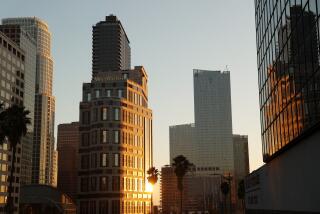Rents and Vacancies Begin to Stabilize in L.A. County Commercial Office Market
- Share via
The Los Angeles County commercial office market appears to have stabilized, with vacancies and rents flattening out in the second quarter and downtown L.A. emerging as one of the strongest central business districts in the nation.
The office vacancy rate in the county was 17.9% in the quarter, compared with 18% a year earlier, and the average rent was $2.05 per square foot, compared with $2.03, according to a report Tuesday from Cushman & Wakefield, one of the nation’s largest commercial brokerages.
What’s more, the county suffered a net loss of only 41,500 square feet of occupied space -- a minuscule amount in a market as large as L.A. County.
“We have stabilized,” said Joseph Vargas, Cushman’s senior managing director in Los Angeles.
The office market trend reflects a slight improvement in Los Angeles County unemployment, which fell to 6.6% in May from 6.9% in May 2002, said Jack Kyser, chief economist of the Los Angeles County Economic Development Corp.
Any improvement in the economy will lead to “slow, slow recovery toward equilibrium” in the office sector, Vargas said. Equilibrium is generally defined as when about 10% of the office supply is vacant.
Many businesses -- including some that want more than 100,000 square feet -- are looking for space in Los Angeles County, Vargas said, though most of the deals probably won’t be completed until 2004, when the market could begin to fully rebound.
As it is, the flattening of vacancy rates and rents means that “people are getting on with their lives” after many months of sitting on the fence, said broker Joe Faulkner, executive managing director of Charles Dunn Co. “They’re making commitments.”
For almost two years, many tenants have been cagey about settling into a particular office. Some demanded short-term renewals of their leases, for as little as a year, because they were uncertain about their business plans or were gambling that rents would fall. Others would lease space only month to month, and strapped landlords went along.
Many business owners now desire more stability and want to end “living in such limbo,” Faulkner said. “They’re feeling better about the future. They think the worst is past.”
If this is indeed the bottom, this cycle has been less painful than the slump of the early 1990s, when the economy declined just as many new buildings were opening and the vacancy rate spiked to 23% in 1992.
The recent vacancy-rate low was 12.7% in the third quarter of 2000.
One of the bright spots for landlords is downtown Los Angeles, one of only two central business districts in the country not in a downturn of falling rents and rising vacancies. The other is Washington, D.C.
And only downtown L.A. is considered to be on the upward swing of the real estate cycle, according to Cushman & Wakefield, based on rent and overall vacancy trends, employment forecasts, tenant base and projects in the construction pipeline.
“The good news is that it appears the worst is over,” Vargas said, “however, the Los Angeles central business district still has some way to go before reaching equilibrium.”
The second-quarter vacancy rate in downtown was 19.9%, with landlords asking for an average of $2.04 a foot, compared with 17.9% and $1.98 a year ago. Among the large tenants searching for space in the business district are Bank of America Corp., City National Corp., SBC Communications Inc. and at least two law firms, Faulkner said.
Downtown’s largest office landlord, Robert F. Maguire, said the area is benefiting from new cultural amenities and a housing boom, along with Southern California’s best supply of public transportation.
“If a couple of big tenants that are looking [for space] land downtown, there will be a big increase in positive absorption sometime this year or early 2004,” said Maguire, president of Maguire Properties Inc., which became a publicly traded real estate investment trust last month.
The Tri-Cities market of Burbank, Glendale and Pasadena remained among the strongest in Los Angeles County with a second-quarter vacancy rate of 15.2% and rents of $2.04 per square foot, including sublease space, compared with 20.2% and $2 a year ago.
Vacancy on the county’s Westside was more than 17.6% with landlords asking for an average of $2.67 per square foot, compared with 18.4% and $2.52 a year ago. The south county market, including Long Beach, Torrance and El Segundo, showed a 19.9% vacancy rate at $1.89 per square foot in rent, compared with 18.3% and $1.99.
Wilshire Center had a 14% vacancy rate at $1.65 per square foot.
The west San Fernando Valley, including Woodland Hills, was 16.5% vacant at $2 a square foot. The central Valley, from Sherman Oaks to Newhall, was 11.9% vacant at $1.88 a foot. The north Valley, which includes Calabasas and Simi Valley, was 15.1% vacant at $2 a foot.
In the San Gabriel Valley, 16.4% of the space was vacant with landlords asking for $1.76 per square foot.
Orange County had a vacancy rate of 18.3% and average rent of $1.96 compared with 17.6% and $2.05 a year ago.
Perhaps the best submarket for landlords was the Burbank Media District, with an overall vacancy rate of 13.9%. The worst was the office district around Los Angeles International Airport, where vacancy was more than 30%.
More to Read
Inside the business of entertainment
The Wide Shot brings you news, analysis and insights on everything from streaming wars to production — and what it all means for the future.
You may occasionally receive promotional content from the Los Angeles Times.











